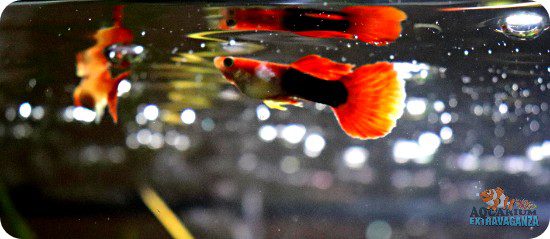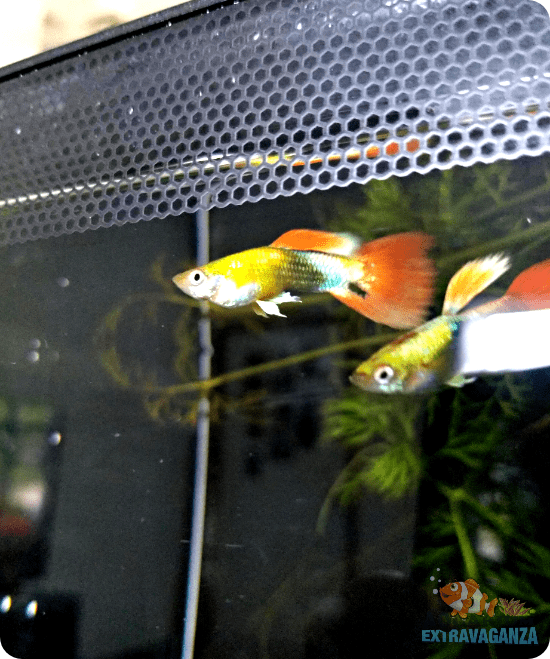I find guppy fish, fascinating to me that they have the ability to change gender through breeding, which has captivated scientists for decades.
This unique behavior of female guppies changing gender sparks my curiosity and I’m eager to understand the reasons behind it.
As a breeder, I have focused my studies on female guppies’ breeding and mating behaviors, as it offers valuable insights into this intriguing phenomenon.
By understanding the behavior and reproductive strategies of female guppies, I am able to delve into the intricacies of their breeding and mating dynamics.
Based on my experience and expertise, I can offer actionable advice when it comes to studying female guppies.
Observing their behavior closely and documenting any patterns or changes is important.
By doing so, we can gain a deeper understanding of their breeding and mating strategies.
Providing a suitable environment with ample space and hiding spots can enhance their breeding success.
In my journey of studying female guppies, I have discovered that their behavior is not only whimsical but also strategically driven. They exhibit unique reproductive strategies that contribute to their ability to change gender.
Female guppies showcase their remarkable evolutionary capabilities by embracing their freedom to adapt.
To truly understand the wonders of female guppies, one must explore their world with an open mind. It is crucial to approach this topic with a sense of awe and respect for the incredible nature of these fish.
We will examine whether guppy males can change from male to female or vice versa, shedding light on the factors that influence this remarkable transformation in the guppy population.
This research will provide insight into guppy breeding and mating behaviors.
From adult guppies to young fry, we will explore the circumstances in which guppy gender changes occur, including guppies mating with females in aquariums.
In aquariums, guppies are known for their unique reproductive strategies, such as internal fertilization, where the female stores sperm from previous matings to fertilize her fry. It’s truly fascinating to witness these complex reproductive processes in action. Discover how these remarkable creatures can change their genders.
The Phenomenon of Gender Change in Guppies
Guppies, those colorful little fish that many people keep as pets, have a fascinating ability to change their gender. This applies to both males and females. This means females can switch from being male to female or vice versa. Let’s explore this phenomenon and how it happens with female and male guppies.
Guppies Possess Both Male and Female Reproductive Organs Simultaneously
Guppies are not strictly male or female, unlike humans and many other animals. They possess both male and female reproductive organs at the same time. This condition is known as hermaphroditism. It allows guppies to reproduce with either males or females, giving them more options.
Environmental Cues Can Influence Guppy Gender Change
Environmental cues influence the ability of guppies to change their gender. Factors such as social interactions, population density, and availability of resources can all play a role in triggering gender change in guppies.
Guppy Gender Change Occurs Through Protandry or Protogyny
Gender change in guppies happens through a process called protandry or protogyny. Protandry is when a fish changes from male to female, while protogyny is the opposite – changing from female to male. These transitions occur gradually over time.
The Adaptive Advantages of Gender Change
The ability of guppies to switch genders provides adaptive advantages for survival and reproduction. For example, if there is a shortage of males in a population, some females can transition into males to fill that role and ensure successful mating opportunities.
Understanding the Reasons Behind Gender Change in Fish
Guppies, a fish species known for their vibrant colors and patterns, can change their gender. This phenomenon occurs in response to environmental factors and impacts the female guppy population. Male guppies play a crucial role in this process through mating behaviors. Hormonal changes play a significant role in triggering gender transformation in female guppies. These changes affect the females’ reproductive system and can lead to the production of sperm.
Environmental Factors and Gender Change
Environmental factors such as temperature, population density, and availability of resources can influence the gender change in fish, including female guppies and male guppies. These factors can also impact the reproductive success of females and the survival of their fry. For example, when guppies are exposed to high temperatures, it may lead to an increase in male-to-female sex reversal in fry. Similarly, overcrowding or limited food resources can also impact the gender balance within a fish population, especially for female guppies. The size of the females and the number of fry they produce can also be affected.
Hormonal Influence on Gender Transformation
Hormones can play a crucial role in regulating reproductive processes and influencing the development of sexual characteristics in female guppies. These hormones can also affect the size of the fry produced by the females. Additionally, guppies have the ability to change gender, transitioning from male to female or vice versa. This gender transition is influenced by factors such as fry production and size. In some cases, hormonal imbalances or fluctuations can trigger gender change in females, specifically female guppies. This can affect the development and growth of fry. For instance, exposure to certain chemicals or pollutants may disrupt female hormone levels, including female guppies, and result in altered sexual development in fry.
Reproductive Advantage as a Driving Force
One of the main reasons why male guppies change their gender is to gain a reproductive advantage over females and produce more fry. By switching genders, male guppies can maximize their chances of successful reproduction by attracting females and producing fry. For example, if there is a shortage of males within a population, some females may transform and fry into males to ensure that reproduction continues.
Understanding why male guppies exhibit this behavior helps us comprehend their evolutionary strategies for survival and adaptation. Male guppies often engage in elaborate courtship displays to attract females. The fry, or baby guppies, result from successful mating between males and females. By studying the behavior of male guppies and their interactions with females, we can gain insights into their reproductive strategies and how they have evolved over time. The blog post highlights how male guppies respond to changing environmental conditions and maintain reproductive success with females and fry.
Research on Guppy Gender Switch
Extensive scientific studies have confirmed that guppies can indeed change their sex. Researchers have observed distinct physiological changes during male guppies’ gender transformation. Experimental manipulations have demonstrated the impact of environmental factors on sex reversal in guppies. Genetic analysis has revealed specific genes associated with regulating sex determination in guppies. These fish can change gender to male or female.
Scientific Studies
Scientific evidence supports the notion that guppies possess the ability to switch genders. Numerous research studies have provided concrete evidence for the phenomenon of male guppies. These studies involve observing guppies over time and documenting changes in their reproductive organs, behavior, and genetic makeup.
Physiological changes during gender transformation
Researchers have closely monitored guppies undergoing gender change and identified distinct physiological alterations. Male-to-female transformations involve the development of female reproductive organs such as ovaries, while female-to-male transformations result in the growth of male reproductive structures like testes.
Environmental factors influencing sex reversal
Experimental manipulations have shed light on how environmental factors can influence gender change in guppies. Studies have shown that altering temperature, hormone levels, or social dynamics within a population of male guppies can induce sex reversal. For instance, exposing male guppies to higher temperatures can trigger a shift towards female characteristics.
Genes regulating sex determination
Genetic analysis has uncovered specific genes responsible for regulating sex determination in guppies. Researchers have identified essential genes involved in determining whether an individual develops as male or female during its early stages of development. Understanding these genetic mechanisms provides valuable insights into the complex process of gender change in guppies.
Factors Contributing to Sex Transition in Guppies
Various factors can influence the gender dynamics of guppies. Let’s explore some of the critical factors contributing to gender change in male guppies, these colorful fish.
Social Interactions within Guppy Populations
Social interactions play a significant role in determining the likelihood of sex reversal among guppies. Male guppies, these fish, live in groups, and their behavior within these populations can impact their gender development. For instance, dominant males can suppress female development, leading to more males changing into females.
Environmental Conditions: Temperature and Population Density
Environmental conditions can also impact guppy gender dynamics, including the possibility of guppies undergoing sex change. Temperature plays a crucial role, as warmer water temperatures have been associated with a higher incidence of sex reversal in guppies. Population density can influence gender change, with overcrowded conditions potentially triggering sex reversal in males or females.
Competition for Resources
Competition for resources is another factor that contributes to gender change in guppies. When resources such as food or territory are limited, it can lead to increased competition among male guppies. This competition can result in hormonal changes that may trigger sex reversal.
Understanding these factors is essential for researchers studying guppy populations and aquarium enthusiasts who want to create optimal conditions for their pet guppies.
Implications of Gender Change for Guppy Populations
Gender flexibility in guppies has several important implications for their populations. Let’s take a closer look at these implications:
Increased Genetic Diversity
Guppy populations benefit from gender change as it allows for increased genetic diversity. When guppies have the ability to switch genders, they can produce offspring with a broader range of genetic traits. This genetic variation helps populations adapt and thrive in different environments.
Influence on Mating Patterns and Reproductive Success
The ability of guppies to change gender can significantly influence their mating patterns and reproductive success. In some cases, males may undergo sex reversal and transform into females, impacting mating dynamics within a population. This flexibility ensures that reproduction is not solely dependent on a limited number of individuals.
Effective Population Management and Conservation
Understanding the consequences of sex reversal in guppies is crucial for effectively managing and conserving their populations. By studying how gender change affects population dynamics, researchers can develop strategies to maintain healthy and sustainable guppy populations.
Survival Advantage in Changing Environments
The ability to switch genders provides guppies with a survival advantage in changing environments. For example, if there is an imbalance between male and female guppies due to predation or other factors, those individuals capable of changing gender can help ensure successful reproduction continues.
Managing Guppy Sex Gender Dynamics in Aquariums
Maintaining a balanced male-to-female ratio is crucial for managing guppy populations in aquariums. By providing suitable environmental conditions, such as optimal temperature and hiding spots, you can reduce stress-induced sex changes among guppies.
Separating dominant males from other males can prevent excessive male-to-female gender transformation. This helps to maintain a healthier population and prevents aggressive behavior among the males.
Regular monitoring and observation are necessary to ensure the well-being of guppies in captivity. Monitor their behavior, especially during mating periods, to identify signs of stress or imbalance.
To effectively manage guppy gender dynamics in your aquarium, here are some key tips:
Provide Suitable Environmental Conditions
-
Maintain an optimal water temperature for guppies (around 75-82°F) to promote healthy growth and reproduction.
-
Create hiding spots using plants or decorations to give female guppies a safe space away from persistent males.
Separate Dominant Males
-
If you notice one male dominating others excessively, consider separating him into another tank or sectioning off part of the tank with a divider.
-
This prevents the dominant male from harassing other males and allows females to interact freely without constant attention.
Regular Monitoring and Observation
-
Observe your guppies regularly to detect any signs of stress or aggression.
-
Look out for sudden changes in behavior, such as increased aggression or isolation.
By following these guidelines, you can create a harmonious environment for your guppy community and minimize gender changes caused by stress or dominance. Remember that maintaining balance is essential for your aquarium fish’s overall health and well-being.
The Fascinating World of Guppy Gender Change
I have explored the reasons behind this unique ability and examined scientific evidence and research on the topic. From my findings, it is clear that guppies possess remarkable adaptability.
Understanding the factors contributing to gender change in guppies is crucial for managing their dynamics in my aquarium. As an aquarium enthusiast, I ensure the well-being of these fascinating creatures by providing a suitable environment and monitoring population dynamics. I take into consideration how gender change impacts guppy populations and its implications on their overall health.
In my experience, it is important to create a balanced and stable environment for guppies. This includes providing appropriate water conditions, a well-balanced diet, and suitable tank mates. By doing so, I have observed healthier and more vibrant guppy populations.
I have found that closely monitoring the population dynamics and being proactive in addressing any issues can greatly contribute to the well-being of guppies. Regular water testing, observing behavior changes, and adjusting feeding schedules are some of the actions I take to ensure the optimal health of my guppies.
My expertise in managing guppy populations has taught me the importance of understanding their unique abilities and behaviors. By applying this knowledge and sharing it with fellow enthusiasts, we can contribute to the long-term sustainability of guppies and other aquatic organisms.
Together, we can create a thriving and vibrant community of guppy enthusiasts.
FAQs
Can all guppies change their gender?
No, not all guppies have the ability to change their gender. Only certain species within the Poecilia genus exhibit this remarkable trait, such as Poecilia reticulata (commonly known as fancy guppies).
How does gender change occur in guppies?
Gender change in guppies occurs through a process called sequential hermaphroditism. Initially born as males or females, some individuals undergo a transformation later in life due to social cues or changes in environmental conditions.
What triggers gender change in guppies?
The exact triggers for gender change in guppies are still being studied. However, research suggests that factors such as population density, sex ratios within groups, hormone levels, and social interactions play significant roles in initiating this transformation.
Can female-to-male transitions occur multiple times?
Yes, female-to-male transitions can occur multiple times in guppies. This ability to switch genders throughout their lifespan allows them to adapt to changing conditions and maximize reproductive success.
Are there any negative effects of gender change on guppies?
While gender change provides advantages for guppies in terms of reproductive opportunities, it can also have potential drawbacks. For example, the energy required for a male-to-female transition may reduce overall fitness and lifespan. Aggressive behaviors during gender transitions can lead to stress and physical injuries.



